

Getting Started Guide 7.5
This document is Copyright © 2023 by the LibreOffice Documentation Team. Contributors are listed below. This document may be distributed and/or modified under the terms of either the GNU General Public License (https://www.gnu.org/licenses/gpl.html), version 3 or later, or the Creative Commons Attribution License (https://creativecommons.org/licenses/by/4.0/), version 4.0 or later. All trademarks within this guide belong to their legitimate owners.
Contributors for this edition:
Peter Schofield
Jean Hollis Weber
Olivier Hallot
Contributors for previous editions:
Amanda Labby
Dave Barton
Hazel Russman
Jean Hollis Weber
Jeremy Cartwright
John A Smith
Jorge Rodriguez
Kees Kriek
Martin Saffron
Olivier Hallot
Paul Figueiredo
Ron Faile Jr.
Skip Masonsmith
Steve Fanning
Please direct any comments or suggestions about this document to the Documentation Team forum at https://community.documentfoundation.org/c/documentation/loguides/ (registration is required), or send an email to: loguides@community.documentfoundation.org.
Note
Everything sent to a forum, including email addresses and any other personal information that is written in the message, is publicly archived and cannot be deleted. Emails sent to the forum are moderated.
Published July 2023. Based on LibreOffice Community.
Other versions of LibreOffice may differ in appearance and functionality.
Some keystrokes and menu items are different on macOS from those used in Windows and Linux. The table below gives some common substitutions used in this document. For a detailed list, see LibreOffice Help.
|
Windows or Linux |
macOS equivalent |
Effect |
|
Tools > Options |
LibreOffice > Preferences |
Access setup options |
|
Right-click |
Control+click, Ctrl+click, or right-click depending on computer setup |
Open a context menu |
|
Ctrl or Control |
⌘ and/or Cmd or Command, depending on keyboard |
|
|
Alt |
⌥ and/or Alt or Option depending on keyboard |
Used with other keys |
|
F11 |
⌘+T |
Open the Styles deck in the Sidebar |
Installing LibreOffice onto a computer depends on the computer operating system. Refer to the computer user guide and operating instructions for information on how to install a software application. During installation of LibreOffice, the following happens depending on the computer operating system:
Windows — a desktop icon is created during the installation of LibreOffice.
Linux — entries for LibreOffice and each of the LibreOffice modules appear in Applications. Desktop icons can be created for LibreOffice and each of its modules. Refer to the operating system help or user guide for more information on how to create a desktop icon.
macOS — an entry for LibreOffice is added to Applications. A desktop icon can be created for LibreOffice. Refer to the operating system help or user guide for more information on how to create a desktop icon.
Clicking on LibreOffice in Applications, or a desktop icon, opens the LibreOffice Start Center (Figure 1) where individual modules of LibreOffice can be selected and opened. Also, a LibreOffice module can be opened using one of the following methods:
Click on the name of a LibreOffice module listed in the Start Center to open the module and create a new file. For example, click on Impress Presentation and a new presentation opens.
Figure 1: LibreOffice Start Center
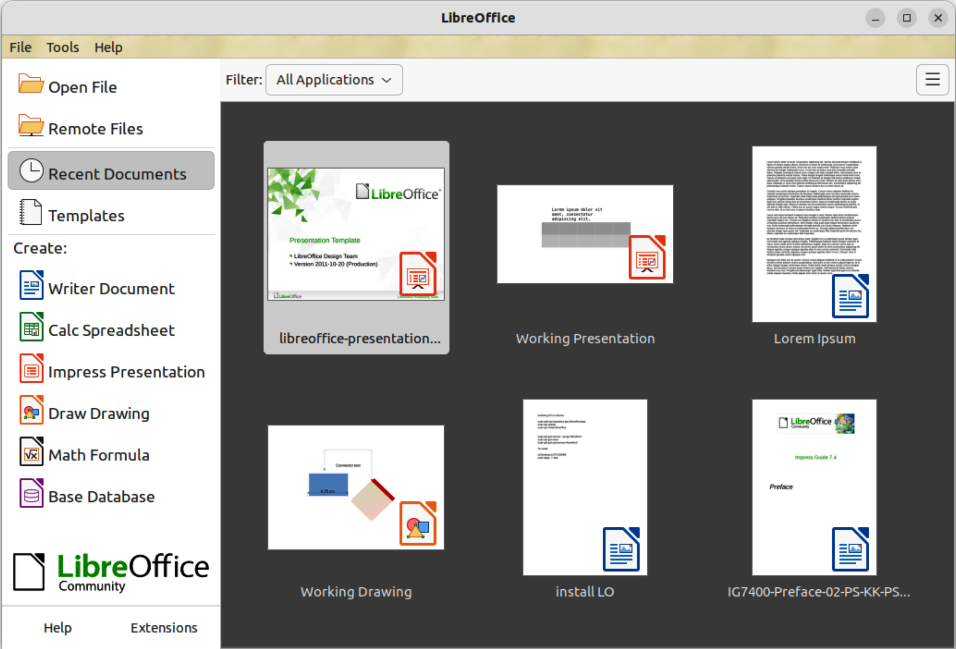
Click on a file displayed in the Start Center to open an existing file and the applicable LibreOffice module also opens.
Click on Templates in the Start Center and the available LibreOffice templates are displayed. Click on the required template to create a new file and the applicable LibreOffice module opens.
Click on Open File to open the Open file browser. Navigate to the file location, select it, then click on Open. This also opens the applicable LibreOffice module.
Click on Remote File to open the Remote Files file browser. Navigate to the file location, select it, then click on Open. This also opens the applicable LibreOffice module.
To reduce the number of files displayed in the Start Center, select a LibreOffice module from the Filter drop-down list. Only files that can be opened by the selected LibreOffice module are displayed in the Start Center.
Note
LibreOffice can also be started by double-clicking the filename of an ODF document in a folder, or file browser. The document opens and the applicable LibreOffice module also opens. For more information on opening files, see “Opening existing documents” on page 1.
To close LibreOffice completely depends on the computer operating system:
Windows and Linux — go to File > Exit LibreOffice on the Menu bar.
Windows and Linux — use the keyboard shortcut Ctrl+Q.
Windows and Linux — with the last LibreOffice document open, click on the X on the right of the title bar.
macOS — go to LibreOffice > Quit LibreOffice on the Menu bar.
macOS — use the keyboard shortcut ⌘+Q
Note
If any documents have not been saved since the last change, a warning message is displayed. Select whether to save or discard the changes.
The main window is similar in each LibreOffice module with some details varying between the modules. For more information, see the relevant chapters in this user guide for Writer, Calc, Draw, Impress, Base, and Math.
The common features included in each LibreOffice module are Title bar, Menu bar, and Standard toolbar at the top of the window and the Status bar at the bottom of the window. The tools and information available on each Standard toolbar and Status bar do vary between each LibreOffice module.
Note
By default, LibreOffice commands are grouped in menus and toolbars called the Standard Toolbar user interface. Other user interface variants are available, displaying contextual groups of commands and contents. Go to View > User Interface on the Menu bar to change the user interface. For more information, see Chapter 13, Customizing LibreOffice.
The Title bar is located at the top of the LibreOffice window. It shows the file name of the current document. If the document has not been saved and named, the document name will be Untitled X, where X is a number. Untitled documents are numbered in the order in which they are created.
The Menu bar is located below the Standard toolbar in Windows and Linux operating systems, and at the top of the window in macOS. When selecting one of the menus, a submenu drops down to show further options, including:
Commands that directly cause an action, for example File > Close or Save.
Commands that open dialogs. These are indicated by three dots following a command, for example Edit > Find and Replace… on the Menu bar.
Commands that open submenus are indicated by a right-pointing chevron ˃ following a command. Moving the cursor onto one of these commands opens a submenu containing further commands, for example View > Rulers > Rulers, or Vertical Rulers.
Keyboard shortcuts that can be used for some commands.
For example, the default Menu bar for Writer contains the following:
File
Edit
View
Insert
Format
Styles
Table
Form
Tools
Window
Help
LibreOffice has two types of toolbars: docked and floating. Docked toolbars can be moved to different locations, or made into a floating toolbar. All floating toolbars can be docked. In a default LibreOffice installation, the Standard toolbar is docked at the top of the window and this docking position is consistent across all of the LibreOffice modules.
In a default LibreOffice installation, the second toolbar in a docked position at the top of the window depends on which LibreOffice module has been opened. For example, when Writer or Calc are opened, the second docked toolbar is the Formatting toolbar.
The second toolbar can also be context-sensitive and changes to provide the relevant tools for the object selected. For example, when a graphic object is selected in Writer, the Formatting toolbar is replaced by the Drawing Object Properties toolbar, providing tools for formatting graphics. When the graphic object is deselected, the Drawing Object Properties toolbar closes and the Formatting toolbar reopens.
Note
When it is necessary to reduce the number of toolbars displayed and provide more space for a document, the user interface can be changed to a single-toolbar as an alternative to the default double-toolbar user interface. This single-toolbar user interface contains the most-used commands. To activate a single toolbar user interface, go to View > User Interface and select Single Toolbar from the Select Your Preferred User Interface dialog. For more information, see Chapter 13, Customizing LibreOffice.
To display a toolbar, go to View > Toolbars on the Menu bar, and select the name of a toolbar from the submenu. An active toolbar displays a check mark next to its name.
To close a toolbar, use one of the following methods:
Go to View > Toolbars on the Menu bar and deselect the toolbar.
Right-click in an empty space between the icons on a toolbar and select Close Toolbar from the context menu.
Note
Floating toolbars created from tool palettes are not listed in the View menu, but are displayed in the LibreOffice window.
Clicking on the small triangle ▼ to the right of a tool icon displays submenus containing further commands, tool palettes, or alternative methods of selecting items.
A tool palette is a pop-up collection of tools attached to a single tool on a toolbar. Tool palettes can be made into floating sub-toolbars using the following example.
Figure 2: Example of creating floating sub-toolbar from a tool palette
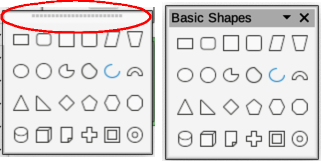
1) Click on Basic Shapes on the Drawing toolbar to open the tool palette.
2) Click on the toolbar handle (highlighted in Figure 2) and drag the tool palette onto the open document.
3) Release the toolbar handle and the tool palette becomes a floating toolbar.
Note
If the toolbar handle is not visible, the tool palette, or toolbar, is locked into its docked position and has to be unlocked. See “Locking and unlocking toolbars” below for more information.
To lock ALL toolbars into place preventing all toolbars from being moved, go to View > Toolbars on the Menu bar and select Lock Toolbars on the submenu. LibreOffice has to be restarted to lock all toolbars. The command Lock Toolbars has a check mark next to it, indicating that all toolbars are locked.
To unlock ALL toolbars allowing all toolbars to be repositioned, or turned into a floating toolbar, go to View > Toolbars on the Menu bar and select Lock Toolbars on the submenu. LibreOffice has to be restarted to unlock all toolbars. The check mark is removed from the command Lock Toolbars indicating that all toolbars are now unlocked.
To lock a single toolbar to prevent it from being repositioned, or turned into a floating toolbar, right‑click in an empty space on the toolbar and select Lock Toolbar Position from the submenu that opens. A check mark appears against Lock Toolbar Position.
To unlock a single toolbar so that it can be repositioned, or used as a floating toolbar, right‑click in an empty space on the toolbar and select Lock Toolbar Position from the submenu that opens. The check mark next to Lock Toolbar Position is removed.
Toolbars that are not locked and in a docked position have a toolbar handle at the left end of the toolbar. This dotted toolbar handle is highlighted in the example shown in Figure 3.
Figure 3: Example of toolbar handles

1) Move the cursor over the toolbar handle, which is the small vertical bar of dots to the left of a docked toolbar. The cursor changes shape to the moving shape used by the computer system.
2) Click on the toolbar handle and drag the toolbar to a new docked position, or create a floating toolbar, then release the toolbar. The toolbar handles disappear when the toolbar becomes a floating toolbar.
A floating toolbar is moved using one of the following methods:
Click in the toolbar title bar and drag the toolbar to a new floating position in the main window, then release the toolbar.
To dock a floating toolbar, click in the toolbar title bar and drag the toolbar into a docking position. The docking position can be at the top, left side, bottom of the main window.
To dock a floating toolbar, click on the downward triangle ▼ on the toolbar title bar and select Dock Toolbar from the available options. The toolbar is docked in its default position. For example, the docked position for the Bullets and Numbering toolbar is at the bottom of the main window.
Note
A docking position is indicated by a hashed border around the toolbar. When this hashed border appears, release the toolbar and the toolbar is docked.
Some toolbars in LibreOffice are context sensitive and only open when an object is selected, or the cursor has been positioned in text. The following are examples of toolbars being context sensitive:
The cursor is positioned in a table and the Table toolbar opens.
The cursor is positioned in an ordered or unordered list, and the Bullets and Numbering toolbar opens.
An image is selected and the Image toolbar opens.
Toolbars can be customized by adding tools listed in Visible Buttons, or by adding new tools to a toolbar. To access the customization options for a toolbar, right-click in an empty space on a docked toolbar, or click on the downward triangle ▼ on the title bar of a floating toolbar to open a context menu.
Select Customize Toolbar to open the Customize dialog to add more tools to the toolbar. For more information on customization, see Chapter 13, Customizing LibreOffice.
Select Dock Toolbar to dock the selected floating toolbar in its default position. The toolbar can be moved to a different docked position.
Select Dock All Toolbars to dock all floating toolbars in their default positions. The toolbars can be moved to different docked positions.
Select Lock Toolbar Position to lock a docked toolbar into its docked position.
Select Close Toolbar to close the selected toolbar, or click on the X on the right of the toolbar title bar.
Select Visible Buttons and select the required tool from the options in the context menu. Tools already installed on a toolbar are indicated by a check mark next to the tool icon. The tools are added to the toolbar in the same order as the tools appear in the context menu. That is, the top tool in the Visible Buttons list is positioned at the left end of the toolbar. The remaining tools are positioned on the toolbar in a position that matches its list position.
Context menus provide quick access to many menu functions and are opened by right-clicking on a paragraph, graphic, or other object. When a context menu opens, the available functions or options depend on the object that has been selected. A context menu is the easiest way to use a function or option, especially if its location in the menus or toolbars is not known.
Context menus can also display applicable keyboard shortcuts if one has been created, or tool icons if available. To use these options, go to Tools > Options > LibreOffice > View (macOS LibreOffice > Preferences LibreOffice > View) and select the options available in Visibility.
The Status bar is located at the bottom of the workspace. It provides information about the document and convenient ways to change some features quickly. It is similar in Writer, Calc, Impress, and Draw, but each LibreOffice module includes some module-specific items. To hide the Status bar, go to View on the Menu bar and deselect Status Bar.
An example of the Impress Status bar is shown in Figure 4. The various areas in the Impress Status bar are as follows:
Slide number
Information area
Table 1: Examples of information
|
Example selection |
Examples of information shown |
|
Text area |
Text Edit: Paragraph x, Row y, Column z |
|
Charts, spreadsheets |
Embedded object (OLE) “ObjectName” selected |
Figure 4: Example of Impress Status bar

Slide number
Information area
Master slide
Cursor position
Object size
Unsaved changes
Digital signature
Text language
Fit slide
Zoom slide
Zoom percentage
Master slide
Cursor position/Object size
When no object is selected, the position numbers show the current position (X and Y coordinates) of the cursor.
When an object is selected and being resized, the object size numbers show the size of the object (width and height).
If an object is selected, the position numbers shows X and Y coordinates of the upper‑left corner and the object size number pair displays the size of the object. These numbers do not relate to the object itself, but to the selection outline, which is the smallest possible rectangle that can contain the visible parts of the object.
When an object is selected, clicking in either of these areas opens the Position and Size dialog.
Unsaved changes
Digital signatures
Text language
Fit slide
Zoom slider
Zoom percentage
The Sidebar is normally open by default on the right side of the Workspace in a LibreOffice module. An example of the Writer Sidebar is shown in Figure 5. Go to View > Sidebar on the Menu bar to display or hide the Sidebar.
The Sidebar has decks containing tools and options to format a document. The number and type of decks used in the Sidebar depend on the type of document and the LibreOffice module that is open. Decks are organized into panels and an icon bar on the right side of the Sidebar allows switching between the different decks.
Figure 5: Example of Properties deck in Writer Sidebar
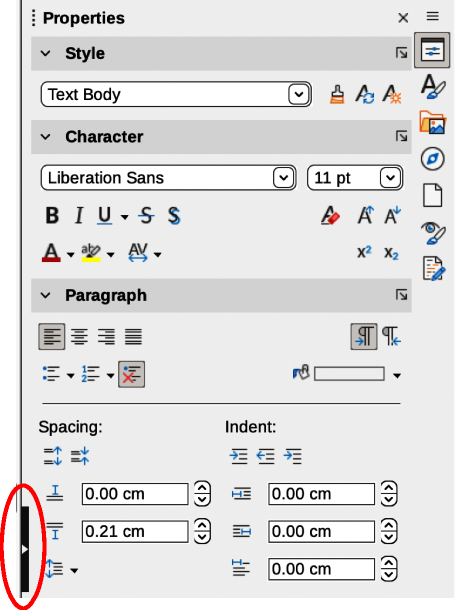
The Sidebar for all LibreOffice modules contains Properties, Styles, Gallery, and Navigator decks. Some LibreOffice modules also have additional decks, for example:
Page and Style Inspector for Writer
Master Slides, Animation, Shapes, and Slide Transition for Impress
Shapes for Draw
Functions for Calc
Menus, toolbars, and Sidebar panels share many functions. For example, making text bold or italic can be done using the Format menu, the Formatting toolbar, or the Properties deck. Some Sidebar panels also have a More Options button, which opens a dialog with additional editing controls. For more detail on the functions and options available on the Sidebar, see the relevant user guide for each of the LibreOffice modules.
To hide the Sidebar, click on Hide/Show button on the left of the Sidebar (highlighted in Figure 5). To show the Sidebar, click on the Hide/Show button again.
Undocking the Sidebar to make it floating is as follows:
1) Click on Sidebar Settings at the top right of the Sidebar.
2) Select Undock from the options available, or use the keyboard shortcut Ctrl+Shift+F10 (macOS ⌘+Shift+F10).
Docking the Sidebar into its position on the main window is as follows:
1) Click on Sidebar Settings at the top right of the Sidebar.
2) Select Dock from the options available, or use the keyboard shortcut Ctrl+Shift+F10 (macOS ⌘+Shift+F10).
A new LibreOffice document can be created using one of the following methods:
With the LibreOffice Start Center open, click on the name of a LibreOffice module to open a new document of that type. For example, click on Impress Presentation and a new presentation is created.
Click on Templates in the Start Center and the available LibreOffice templates are displayed. Click on the required template to create a new file and the applicable LibreOffice module opens.
Go to File > New on the Menu bar and select the type of document from the submenu that opens. The applicable LibreOffice module also opens.
Click on the downward triangle ▼ next to New on the Standard toolbar and select the type of document from the context menu that opens. For example, click on Drawing and a new drawing is created. The applicable LibreOffice module also opens.
Click on New on the Standard toolbar and a new document is created matching the LibreOffice module that is open. For example, if Writer is open and active, a new text document is created.
Use the keyboard shortcut Ctrl+N (macOS ⌘+N) to create a new document. The type of document created depends on which LibreOffice module is open and active. For example, if Calc is open and active, a new spreadsheet is created.
Go to File > Wizards on the Menu bar and select the type of document from the options available in the submenu.
An existing document can be opened using one of the following methods. The applicable LibreOffice module also opens matching the type of document that has been opened.
Click Open File in the Start Center and select the file required from the file browser window that opens.
Go to File > Open on the Menu bar and select the file required from the file browser window that opens.
Click on Open on the Standard toolbar and select the file required from the file browser window that opens.
Use the keyboard shortcut Ctrl+O (macOS ⌘+O) and select the file required from the file browser window that opens.
Click Recent Documents in the Start Center and select the file required from the files displayed in the Start Center.
Go to File > Recent Documents on the Menu bar and select the file required from the list of files displayed in the context menu.
Notes
Renamed or relocated documents may still be listed in the Start Center. Selecting one of these files opens an error message that the file does not exist. To remove the file from the Start Center, hover the cursor over the thumbnail until an X appears in the upper right corner, and then click on the X.
In the Start Center, Open dialog, or file browser the list, or preview, of files displayed can be reduced by selecting the type of file required. For example, to select Text Documents as the file type, only documents that Writer can open are displayed.
For more information on working with files on remote servers, see Chapter 10, Working with File Formats, Security, and Exporting.
LibreOffice will open files compatible with the Open Document Format (ODF) that LibreOffice uses. For example: MS Word (*.doc or *.docx) are opened in Writer; MS Excel (*.xls or *.xlsx) are opened in Calc; MS PowerPoint (*.ppt or *.pptx) are opened in Impress, and so on. See Chapter 10, Working with File Formats, Security and Exporting for more information about working with different file types.
Documents can be saved using one of the following methods:
Save — used to save all changes made, keeping the current filename and location of the file.
Go to File > Save on the Menu bar.
Use the keyboard shortcut Ctrl+S (macOS ⌘+S).
Click on Save on the Standard toolbar.
Save As — used to create a new document, change the filename or file format, or save the file in a different location on a computer system.
Go to File > Save As on the Menu bar.
Use the keyboard shortcut Ctrl+Shift+S (macOS ⌘+Shift+S).
Click on the downward triangle ▼ next to Save on the Standard toolbar and select Save As from the context menu.
Save a Copy — used to save a copy of the current document, for example, in a different location on the computer system. The current document remains open for more editing.
Go to File > Save a Copy on the Menu bar.
Click on the downward triangle ▼ next to Save on the Standard toolbar and select Save a Copy from the context menu.
Save All — used to save all the files that are open in LibreOffice. Go to File > Save All on the Menu bar. This option is only available when more than one LibreOffice document is open.
LibreOffice can save files automatically as part of the AutoRecovery function. Automatic saving automatically overwrites the last saved state of the file. Set up automatic file saving as follows:
1) Go to Tools > Options > Load/Save > General (macOS LibreOffice > Preferences > Load/Save > General) on the Menu bar.
2) In Save, select the option AutoRecovery information every and set the time interval in the box, for example 10 minutes.
3) Click OK to save the selection and close the dialog.
The Navigator lists all objects contained in a document in categories, as shown by the examples from Impress and Writer in Figure 6 and Figure 7, respectively. The Navigator is available as a dialog or Sidebar deck and is opened using one of the following methods:
Navigator dialog, go to View > Navigator on the Menu bar, or use the keyboard shortcut F5 for Windows and macOS, or Ctrl+Shift+F5 for Linux.
Navigator deck on the Sidebar, click on the Navigator icon on the right of the Sidebar, or use the keyboard shortcut Alt+Ctrl+4 for Windows and Linux, or ⌥+⌘+4 for macOS.
To close the Navigator, click on the X on the right of the title bar, or use the keyboard shortcut.
The categories are specific to each LibreOffice module. Click on the right chevron > next to each category name to open the list of objects contained in each category. Also, the Navigator provides some functions that are specific to each LibreOffice module.
Using the Navigator provides an easy method of locating and selecting objects in a document. However, it is recommended to give each object an easily identified name to assist in locating an object, instead of using the default names such as Sheet1, Table1, or Image2, and so on. Right‑click on an object in the Navigator dialog, or Sidebar deck and select Rename from the context menu.
Figure 6: Example of Impress Navigator dialog
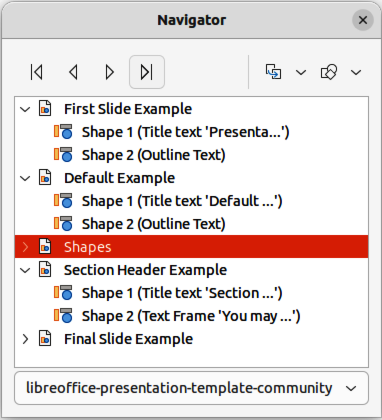
Figure 7: Example of Navigator deck in Writer Sidebar
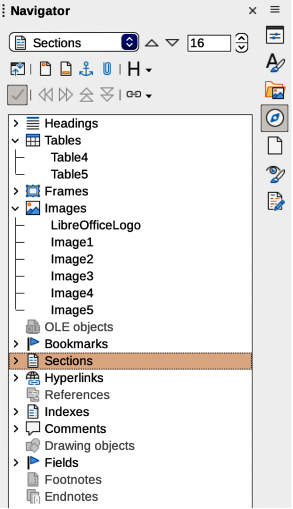
Figure 8: Example of separate windows list
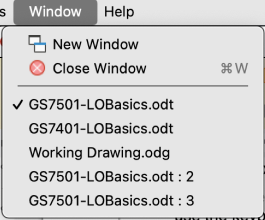
Several views of the same document in LibreOffice can open at the same time. These views are displayed in their own windows and can show different pages, use different zoom levels, or other settings. A change to the document in one window is immediately reflected in the other windows. For example, when using Writer, separate views of a document can be used for copying or moving information from one page to another.
To open a new document window, go to Window > New Window on the Menu bar. In each window opened, the filename of the document is displayed in the title bar. Figure 8 shows an example of separate views of one document being open at the same time. If other LibreOffice documents are open at the same time, this windows list also includes these other documents. The active window has a check mark by its filename in the list. Switch between windows by clicking on a name in the list, or by clicking on the window itself if it is visible on the display.
To close a window, go to Window > Close Window on the Menu bar, use the keyboard shortcut Ctrl+W (macOS ⌘+W).
To undo the most recent change in a document, use one of the following methods:
Use the keyboard shortcut Ctrl+Z (macOS ⌘+Z).
Click on Undo in the Standard toolbar.
Go to Edit > Undo on the Menu bar.
Click the small triangle ▼ to the right of Undo on the Standard toolbar to open a list of changes that can be undone. Multiple consecutive changes can be selected and deleted at the same time.
After changes have been undone, changes can be redone using one of the following methods:
Use the keyboard shortcut Ctrl+Y (macOS ⌘+Y).
Click on Redo in the Standard toolbar.
Go to Edit > Redo on the Menu bar.
Click the small triangle ▼ to the right of Redo on the Standard toolbar to open a list of undo commands that can be redone. Multiple consecutive undo commands can be selected and redone at the same time.
Repeating undo and redo commands can save several repetitive menu navigation clicks, or keyboard shortcuts, especially when a command is taken from a context menu or submenu. To repeat the last undo or redo command applied to a document, use one of the following methods:
Use the keyboard shortcut Ctrl+Shift+Y (macOS ⌘+Shift+Y).
Go to Edit > Repeat on the Menu bar.
Reloading documents discards all the changes made in an editing session after the last document save. To reload a document, go to File > Reload on the Menu bar.
Note
If any changes have been made since the last save, a confirmation dialog opens with a warning message that reloading discards the last changes. Select whether to save, or discard, the changes.
Close a document using one of the following methods:
Go to File > Close on the Menu bar.
In Windows or Linux — click on the X at the right end of the Menu bar.
In macOS — click on the red button at the left end of the title bar.
If the document was the only document open, the following happens:
In Windows or Linux — the document closes and the LibreOffice Start Center opens.
In macOS — the document closes and the Menu bar remains at the top of the screen.
Note
If the document has not been saved since the last change, a confirmation dialog opens with a warning message. Select whether to save, or discard, the changes before closing.
Setting up a default printer depends on the computer and the computer operating system being used. The following are examples of how to setup a default printer on a computer.
Notes
When printing, the name of the default printer installed on a computer appears in the Print tool name, Print Directly tool name, Print dialog, and Printer Settings dialog.
For more information about printing the different types of documents that LibreOffice can create, see the user guides for each LibreOffice module.
Printing options are not available when viewing a LibreOffice Base table or query.
1) Open Settings, then go to Devices > Printers & scanners.
2) Select a printer from the displayed list.
3) Select Manage > Set as default and then close Settings.
1) Open Settings, then go to Printers.
2) Select a printer from the displayed list.
3) Click on the settings icon on the right of the printer name.
4) Select Use Printer by Default from the drop-down list and close Settings.
1) Open System Settings, then open Printers & Scanners.
2) In Default printer select the printer to use as default printer from the drop-down list, then close Settings.
Figure 9: Draw Standard toolbar with Print Directly installed

Quick printing is when an entire document is printed using the default printer settings that is connected to the computer. To quick print the entire document that is open, click on Print Directly on the Standard toolbar.
If Print Directly is not visible on the Standard toolbar, it can be installed as follows:
1) Right-click in a blank area on the Standard toolbar to open a context menu.
2) Select Visible Buttons from the context menu.
3) Select Print Directly from the list of available tools to install it on the Standard toolbar, as shown by the highlighted example in Figure 9.
The options available in the Printer Setup dialog for a printer are as follows:
Printer
Name
Status
Type
Location
Comments
Properties
Options
Note
Options in the Printer Settings dialog is only available in LibreOffice Writer and Calc.
Figure 10: Example of a Printer Setup dialog
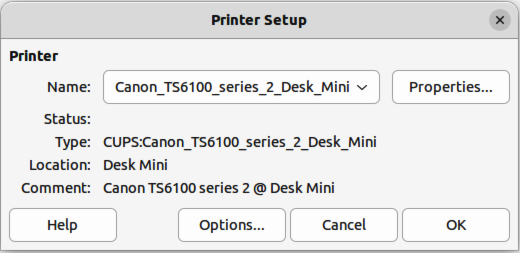
Figure 11: Example of Printer Options dialog
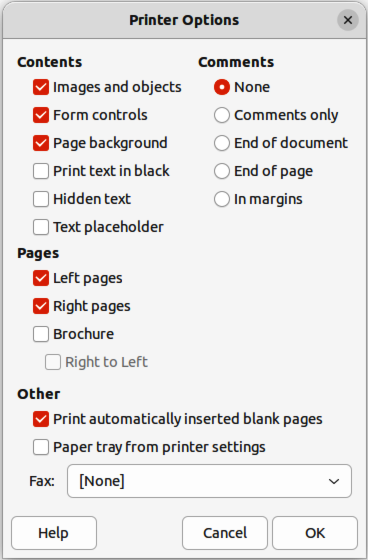
An example of setting up a printer on a computer is as follows:
1) Connect the printer to the computer. Refer to the printer and computer user guides for more information on connecting printers.
2) Go to File > Printer Settings on the Menu bar to open a Printer Setup dialog. Figure 10 shows an example of a Printer Setup dialog.
3) Click on Options in Printer Setup dialog to open the Printer Options dialog. Figure 11 shows an example of a Printer Options dialog.
4) Select the required printer options, then click on OK to save the selection and close the Printer Options dialog.
5) If necessary, click on Properties in the Printer Setup dialog to open a properties dialog for the default printer.
6) Select the required properties, then click on OK to save the selection and close the properties dialog.
7) Click OK to save the printer setup and close the Printer Setup Dialog.
After installing a printer on a computer, the general printing options for LibreOffice can be selected to suit the most common printing method that is going to be used. Go to Tools > Options > LibreOffice > Print (macOS LibreOffice > Preferences > LibreOffice > Print) to open the Options LibreOffice Print dialog (Figure 12). The general print options for LibreOffice are as follows:
Settings for
Defaults
Convert colors to grayscale
Specifies that all colors in a document are printed only as greyscale.
Include transparent objects
If selected, the reduction in print quality for bitmaps also applies to the transparent areas of objects.
Figure 12: Options LibreOffice Print dialog
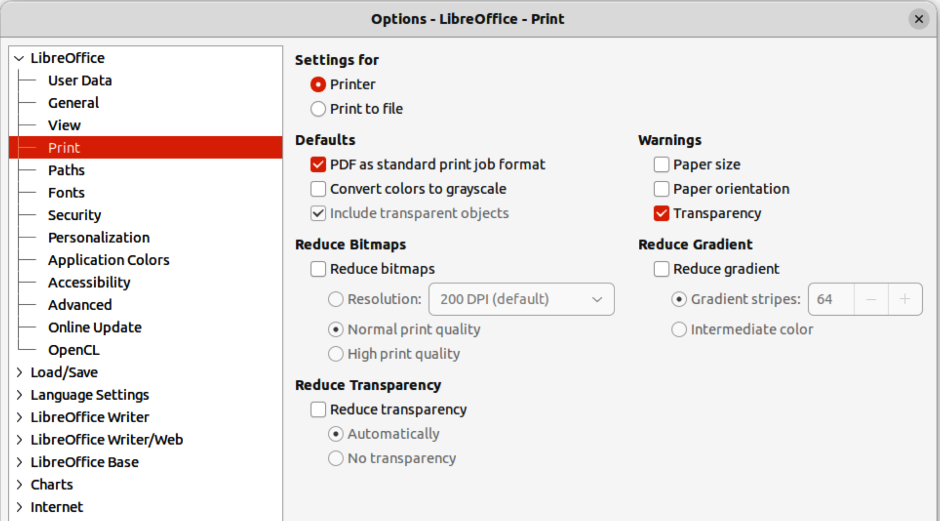
Reduce bitmaps
Resolution
Specifies the maximum print quality in DPI. The resolution can only be reduced and not increased.
High print quality
High print quality corresponds to a resolution of 300dpi.
Normal print quality
Normal print quality corresponds to a resolution of 200dpi.
Note
Reducing the amount of data sent to the printer increases the print speed because the print files are smaller. This makes it easier for printers with a smaller memory when printing large files. However, reducing print data can result in slightly lower print quality.
Reduce transparency
Automatically
Specifies that the transparency is only printed if the transparent area covers less than a quarter of the entire page.
No transparency
When selected, a transparency does not print.
Note
Transparencies cannot be sent directly to a printer. Transparencies must be visible to be calculated as bitmaps and sent to the printer. Depending on bitmap size and the print resolution, a large amount of data may result.
Warnings
Paper size
Select this option if a certain paper size is required for printing the current document. If the paper size used in the document is not provided by the current printer, an error message opens.
Paper orientation
Select this option if a certain paper orientation is required for printing the current document. If the format used by the current document is not available from the printer, an error message opens.
Transparency
Select this option if a warning is required if transparent objects are contained in the document. When printing a document with transparencies, a dialogue box opens to enable selection if the transparency is to be printed.
Reduce gradient
If selected, gradients are printed with reduced quality.
Gradient stripes
Specifies the maximum number of gradient stripes for printing.
Intermediate color
Specifies that gradients are only printed in a single intermediate color.
Go to Tools > Options > LibreOffice module name > Print (macOS LibreOffice > Preferences > LibreOffice module name > Print) to open the printing options dialog for each LibreOffice module. The different print settings for each LibreOffice module are summarized in Table 2. For more information, refer to the specific user guide for each module.
Table 2: Print options in LibreOffice modules
|
Feature |
Writer |
Calc |
Impress |
Draw |
Math |
|
Select pages, sheets, or slides to print |
Yes |
Yes |
Yes |
Yes |
Yes |
|
Print multiple pages, sheets, or slides on one page |
Yes |
Yes |
Yes |
Yes |
No |
|
Print a brochure |
Yes |
No |
Yes |
Yes |
No |
|
Print envelopes |
Yes |
No |
No |
No |
No |
|
Print labels or business cards |
Yes |
No |
No |
No |
No |
|
Preview pages or sheets before printing |
Yes |
Yes |
No |
No |
No |
For more control over printing, open the Print dialog using one of the following methods:
Go to File > Print on the Menu bar.
Use the keyboard shortcut Ctrl+P (macOS ⌘+P).
Click on Print on the Standard toolbar.
The following general options are an example of the options available on the General page of the Impress Print dialog in Windows or Linux (Figure 13).
Printer
Properties
Range and Copies
All Slides
Prints all the slides in the presentation.
Selection
Prints the slides selected in LibreOffice Impress.
Slides
Select the page number(s) to print. For multiple pages, use the format 1, 3, 7 or 1 – 5, 7, 9 for page number selection.
Include
Select from the drop-down list Odd and Even Pages, Odd Pages, or Even Pages.
Figure 13: Impress Print dialog — Impress General page — Windows or Linux
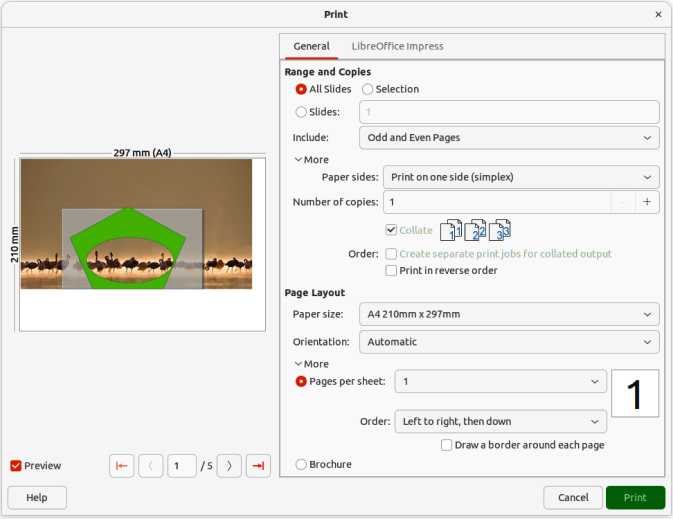
More > Paper sides
Select from the drop-down list Print on one side (simplex), Print on both sides (duplex long edge), or Print on both sides (duplex short edge).
More > Number of copies
Enter number of printed copies required for the document.
More > Collate
Collates multiple printed copies into separate documents.
More > Order
Select from Create separate print jobs for collated output (only available when more than one copy is being printed) or Print in reverse order.
Page Layout
Paper size
Select the paper size to use from drop‑down list
Orientation
Select from the drop-down list Automatic, Portrait, or Landscape.
More > Pages per sheet
Select from the drop-down list how many pages are printed on one sheet of paper.
More > Order
Select from the drop-down list the printing order of multiple pages on one sheet of paper.
More > Draw a border around each page
When multiple slides are printed on one sheet of paper, a border is drawn around each slide.
More > Brochure
Prints the document so the pages can be folded into a brochure or booklet.
The following general options are an example of the options available on the General page of the Impress Print dialog in macOS (Figure 14).
Printer
Presets
Copies
Pages
All
Prints all the pages in the document.
From: to:
Select the page number(s) to print. For multiple pages, use the format 1, 3, 7 or 1–5, 7, 9 for page number selection.
Print in Color
Double-Sided
Media & Quality
Feed from
Select from the drop-down list the paper tray to use if the printer has more than one paper tray.
Media Type
Select from the drop-down list the paper type that has been loaded into the paper tray being used, for example Envelope, Photo, Plain Paper.
Quality
Select the level of printing quality required.
Layout
Pages per sheet
Select from the drop-down list how many slides are printed on one sheet of paper.
Figure 14: Print dialog — Impress General page — macOS
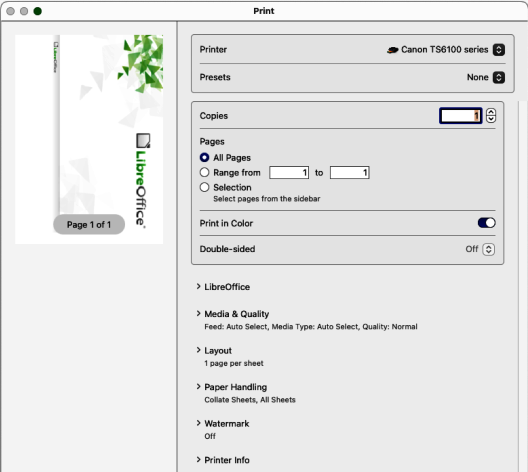
Layout Direction
Select the printing order of multiple slides on one sheet of paper.
Border
When multiple slides are printed on one sheet of paper, a border is drawn around each slide.
Two-Sided
Select from the drop-down list how a multi-page document is going to be bound: Off; Long-Edge binding; Short-Edge binding, Booklet.
Reverse page orientation
If LibreOffice prints the slides in the wrong order, select this option and print the document again.
Flip horizontally
If LibreOffice prints the pages in the wrong orientation, select this option and print the document again.
Paper Handling
Collate sheets
When selected multiple printed copies are collated into separate documents.
Sheets to Print
Select which slides in the document to print from the drop-down list: All pages; Odd only; Even only.
Sheet Order
Select the page printing order from the drop-down list: Automatic; Normal; Reverse.
Scale to fit paper size
Adjusts the printed slide to fit the paper size.
Destination Paper Size
Select a paper size from the options available in the drop‑down list. Only available if Scale to fit paper size has been selected.
Scale down only
Select this option to reduce slide size to fit the paper. Only available if the paper size is smaller than the slide size.
Watermark
Printer info
For more information on using specific printing options available in each LibreOffice module, see the User Guide for each LibreOffice module. For example, specific printing could be as follows:
Individual pages, slides, or drawings.
Range of pages, slides, or drawings.
Selection of text, or graphics (Writer).
Individual sheets, range of sheets, or selected cells (Calc).
Handouts, outlines, or notes (Impress).
Envelopes, labels, or business cards (Writer).
In Writer, Impress, and Draw, documents can be printed so that, when printed, the pages are in the correct order to form a booklet or brochure. The printer procedures below are only examples. Actual brochure printing procedure depends on the computer operating system and type of printer being used. It is best to experiment to find the correct method for brochure printing.
The following procedure is an example of how to create a brochure or booklet using a printer that is only capable of printing single sided.
1) Open the Print dialog using one of the following methods:
Go to File > Print on the Menu bar.
Use the keyboard shortcut Ctrl+P (macOS ⌘+P).
Click on Print on the Standard toolbar.
2) Click on General to open the page for general print options and, if necessary, select a printer from the Printer drop-down list of printers available.
3) Click on Properties to open the printer properties dialog for the printer being used and check the printer is set to the same page orientation as specified for the page setup for the pages. Usually page orientation does not matter, but it is important for brochures.
4) Click OK to close the properties dialog and return to the Print dialog.
5) In Range and Copies, select All Slides. A minimum of four slides is required to create a brochure.
6) In Range and Copies, select the Number of copies required to match the required number of brochures.
7) In Layout, select Brochure.
8) In Range and Copies, select Even slides option in Include.
9) Click OK to print the even slides in the presentation.
10) Take the printed pages out of the printer and put them back into the printer in the correct orientation to print on the other side of the paper. It may be necessary to experiment to find out the correct arrangement for the printer being used.
11) In Range and Copies, select Odd slides option in Include.
12) In Range and Copies, select the same Number of copies used for printing the even slides.
13) Click OK to print the odd slides in the presentation and close the Print dialog.
14) Assemble the brochures and bind them, if necessary.
Printing a brochure on a printer that is capable of double sided, or duplex printing, makes the task of creating brochures a lot simpler.
1) Open the Print dialog using one of the following methods:
Go to File > Print on the Menu bar.
Use the keyboard shortcut Ctrl+P (macOS ⌘+P).
Click on Print on the Standard toolbar.
2) Click on General to open the page for general print options and, if necessary, select a printer from the Printer drop-down list of printers available.
3) Click on Properties to open the printer properties dialog for the printer being used and check the printer is set to the same page orientation as specified for the page setup for the slides. Usually page orientation does not matter, but it is important for brochures.
4) Click OK to close the properties dialog and return to the Print dialog.
5) In Range and Copies, select All Slides. A minimum of four slides is required to create a brochure.
6) In Range and Copies, select Print on both sides (duplex long edge) or Print on both sides (duplex short edge) option. Normally, long edge binding is used for portrait printing and short edge binding is used for landscape printing.
7) In Range and Copies, select the Number of copies required to match the required number of brochures.
8) In Range and Copies, select the Collate option. This option is only active when printing multiple copies of the same document.
9) In Layout, select Brochure.
10) Click OK to close to the Print dialog and print the required number of pages for the brochures.
11) If necessary, bind the brochures to match either long edge or short edge binding.
Figure 15: Print Preview toolbar

In Writer and Calc only, a document can be previewed before it is printed. Print previewing is useful, especially when printing a document double-sided making sure there are no errors before the document is printed. Print previewing is opened as follows:
1) Open Print Preview using one of the following methods. The Print Preview toolbar (Figure 15) opens and the Formatting toolbar closes:
Go to File > Print Preview on the Menu bar.
Click on Toggle Print Preview on the Standard toolbar.
Use the keyboard shortcut Ctrl+Shift+O (macOS ⌘+Shift+O).
2) Select the required preview from Single Page Preview, Two Pages Preview, Book Preview, or Multiple Pages Preview.
3) To print the document from Print Preview, click Print on the Print Preview toolbar to open the Print dialog, then select the printing options and click OK (macOS Print).
4) To close the preview, click on Close Preview on the Print Preview toolbar. The document switches back to normal view and the Formatting toolbar reopens replacing the Print Preview toolbar.
Note
When a document is in Print Preview, the document cannot be edited. If required, click on Book view in the Status Bar to display the document in book format. The document can be edited when using Book view on the Status bar. Click on Single page view to return the document to normal view.
Safe Mode is used to temporarily start LibreOffice with a fresh user profile and disables hardware acceleration. This helps in restoring LibreOffice after it has stopped working, fails to launch correctly, or a file has become corrupted.
Go to Help > Restart in Safe Mode on the Menu bar to open the Safe Mode dialog (Figure 16) providing the following options.
Note
It is recommended to use Safe Mode options successively from the top down because the options get more extreme from the top down.
Restore from backup
Figure 16: Safe Mode dialog
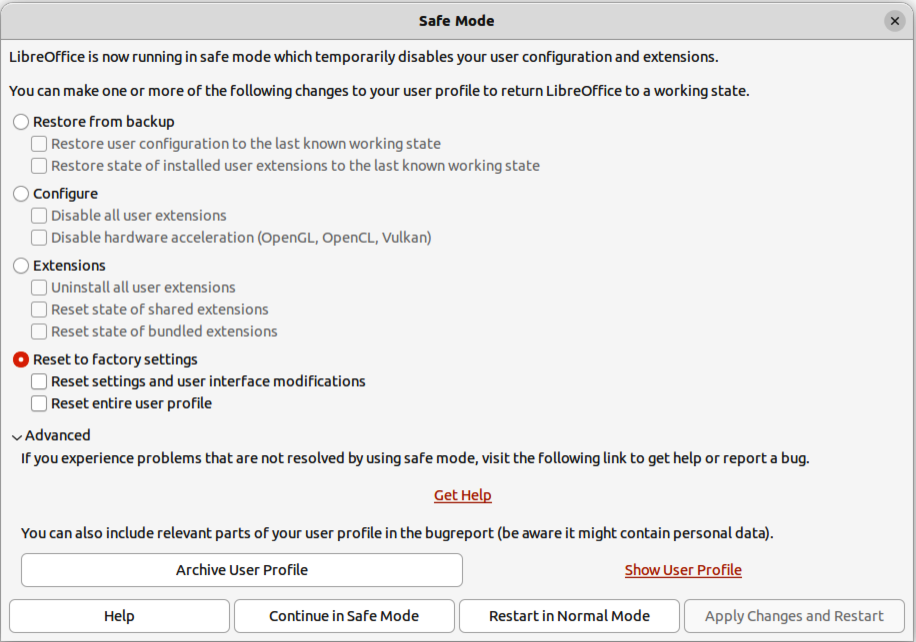
Configure
Extensions
Reset to factory settings
Reset settings and user interface modifications
Reset entire user profile
Continue in Safe Mode
Restart in Normal Mode
Apply Changes and Restart
Note
If problems are not solved using Safe Mode, selecting Advanced provides instructions on receiving further aid.
Using Advanced a zip file can be created of a corrupted user profile. This zip file can be uploaded to the bug tracking system where it can be investigated further by the developers.
However, be aware that an uploaded user profile may contain sensitive information such as installed extensions, personal dictionaries, and settings.